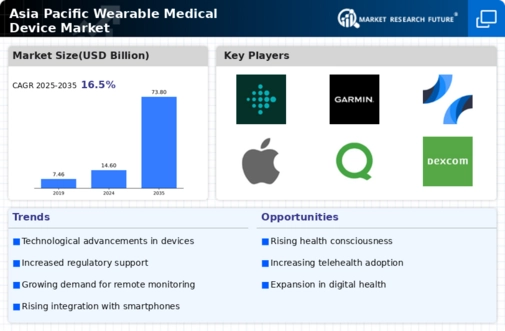Asia Pacific Wearable Medical Device Market Summary
The Asia-Pacific Wearable Medical Device market is projected to grow from 14.6 USD Billion in 2024 to 73.8 USD Billion by 2035.
Key Market Trends & Highlights
Asia Pacific Wearable Medical Device Key Trends and Highlights
- The market is expected to experience a compound annual growth rate (CAGR) of 15.88 percent from 2025 to 2035.
- By 2035, the market valuation is anticipated to reach 73.8 USD Billion, indicating robust growth potential.
- In 2024, the market is valued at 14.6 USD Billion, reflecting a strong foundation for future expansion.
- Growing adoption of wearable medical devices due to increasing health awareness is a major market driver.
Market Size & Forecast
| 2024 Market Size | 14.6 (USD Billion) |
| 2035 Market Size | 73.8 (USD Billion) |
| CAGR (2025-2035) | 15.88% |
Major Players
Samsung Electronics Co., Ltd. (South Korea), Fitbit (United States), Abbott Laboratories (United States), Garmin Ltd. (Switzerland), Lifesense Group (China), Omron Corporation (Japan), Xiaomi Corporation (China), Apple Inc. (United States), Nurotron Biotechnology Co., Ltd. (China), Huawei Technologies Co., Ltd. (China), Qardio, Inc. (United Kingdom), Philips Healthcare (Netherlands), Medtronic plc (Ireland), Dexcom, Inc. (United States), Andon Health Co., Ltd. (China)

















Leave a Comment